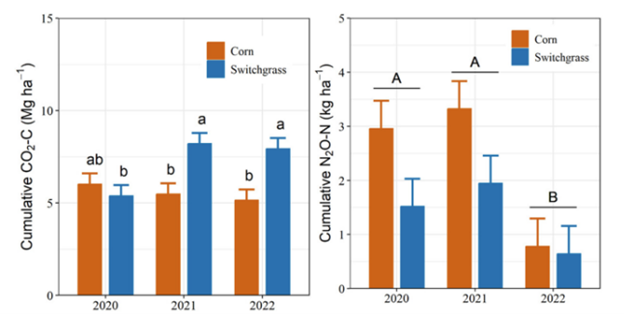Field-scale Evaluation of Ecosystem Service Benefits of Bioenergy Switchgrass
Themes: Feedstock Production, Sustainability
Keywords: Field Data, Perennial Bioenergy Grasses, Soil, Switchgrass
Citation
Namoi, N., Lin, C.H., Jang, C., Wasonga, D., Zumpf, C., Arshad, M.U., Heaton, E., Lee, D.K. April 22, 2025. Data from: “Field-scale Evaluation of Ecosystem Service Benefits of Bioenergy Switchgrass.” University of Illinois. DOI: 10.13012/B2IDB-2726994_V1.
Overview

Purpose-grown perennial herbaceous species are nonfood crops specifically cultivated for bioenergy production and have the potential to secure bioenergy feedstock resources while enhancing ecosystem services. This study assessed soil greenhouse gas emissions (CO2 and N2O), nitrate (NO3-N) leaching reduction potential, evapotranspiration (ET), and water-use efficiency (WUE) of bioenergy switchgrass (Panicum virgatum L.) in comparison to corn (Zea mays L.). The study was conducted on field-scale plots in Urbana, IL, during the 2020–2022 growing seasons. Switchgrass was established in 2020 and urea-fertilized at 56 kg N ha−1 year−1. Corn management followed best management practices for the US Midwest, including no-till and 202 kg N ha−1 year−1 fertilization, applied as urea–ammonium nitrate (32%). Our results showed lower direct N2O emissions in switchgrass compared to corn. Although soil CO2 emissions did not differ significantly during the establishment year, emissions in subsequent years were over 50% higher in switchgrass than in corn, likely due to increased belowground biomass, which was over five times higher in switchgrass. Nitrate-N leaching decreased as the switchgrass stand matured, reaching 80% lower than in corn by the third year. Differences in ET and WUE between corn and switchgrass were not significant; however, results indicate a trend toward reduced WUE in switchgrass under drought, driven by lower aboveground biomass production. Our study demonstrates that switchgrass can be implemented at a commercial scale without negatively impacting the hydrological cycle, while potentially reducing N losses through nitrate-N leaching and soil N2O emissions, and enhancing belowground C storage.
Data
- Cumulative fluxes
- Soil characteristics
- Biomass accumulation, yield
- ANOVA